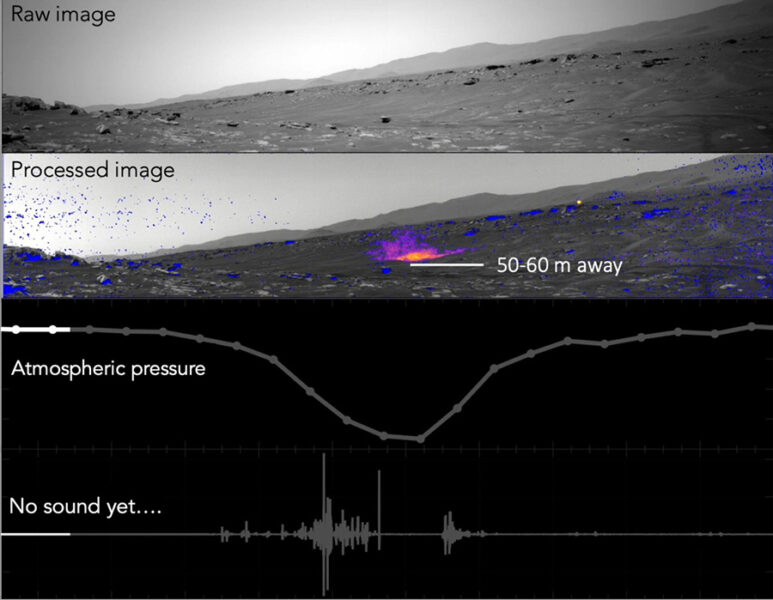The Perseverance rover on Mars has recorded a dust devil using its microphone, providing unprecedented data about these whirlwinds.

NASA / JPL-Caltech / LANL / CNES / CNRS / INTA-CSIC / Space Science Institute / ISAE-Supaero
When on September 27, 2021, a dust devil swept through Jezero Crater on Mars, Perseverance was watching — and listening, with the microphone attached to the SuperCam on the rover's "head."
"Each SuperCam microphone recording lasts only 167 seconds, and we only perform on average eight such recordings a month," says Naomi Murdoch (University of Toulouse, France), who led a study of the data in Nature Communications. "For each microphone recording in the mid-day period there is only a 1 in 200 chance to detect such a dust devil, so we got lucky!"
Listen here:
Besides using its SuperCam microphone, the rover also picked up the dust-laden whirlwind using its Navigation Camera and several sensors from the Mars Environmental Dynamics Analyzer (MEDA). From these measurements, Murdoch and her colleagues detected the whirlwind's pressure drop and change in wind direction. The team estimates that the vortex was 25 meters (82 feet) wide and 118 meters tall — towering taller than the Statue of Liberty over the car-size rover. It traveled at a sedate 5 meters per second (11 mph), though the winds within the vortex whipped about on average at 25 mph.
Dust devils are a normal sight for Perseverance, which had already recorded 91 in the mission's first 216 sols. (It's still unclear why so many whirlwinds cross through Jezero Crater, when Insight in Elysium Planitia hasn't seen any, but it probably has something to do with increased air turbulence in the region.) But this is the first time the rover has encountered one directly, and with its microphone on. Scientists therefore have more information about this particular whirlwind — which seems to be typical of Martian dust devils in general — than about previous events.
Because the Martian atmosphere is so thin, with just 1% the pressure of Earth's at sea level, sound doesn't travel far. A dust devil must pass near or over the rover for the SuperCam microphone to pick it up. But for a nearby event, the microphone can provide important information.
The faster the wind, the louder the sound the microphone picks up, basically acting as a high-frequency wind speed sensor. Also, the hiss that begins midway through the recording comes from the impact of hundreds of dust grains; that sound can help scientists determine the grains' density. (The hiss culminates in a louder "tick" is likely the impact of a larger grain.)
Understanding dust devils, especially the way in which they uplift dust into the air, is useful for planning rover and lander missions. It may also be useful one day for crewed missions, though an astronaut wouldn't notice much from the typical dust devil: besides a slight dimming as the dust blocks the meager sunlight, they wouldn't feel more than a breeze.
"The peak wind speed during this dust devil encounter reached around 40 km/h, and the winds in some dust devils can be even faster than this," Murdoch says. "However, on Mars, the atmosphere is indeed much thinner than on Earth. This means that, even if the wind speed is high, due to the low density Martian atmosphere, the force of the wind is much smaller than on Earth so the astronaut is not going to be blown about too much by the dust devil winds."
Read more about the dust devil in NASA's image release.
 2
2









Comments
OwlEye
December 14, 2022 at 1:43 pm
Thank you, NASA, for the chance to hear the wind from another world.
You must be logged in to post a comment.
RC Silk
December 23, 2022 at 4:37 pm
So while yes, it *is* super cool to hear something from another planet, one would *think* that at the overall cost of that venture, some bright son over at NASA would've *thought* to include Dolby (or some form of hiss suppression) into the sound package. (And possibly the ability to pick up subsonic and/or any ultrasonic frequencies as well.)
You must be logged in to post a comment.
You must be logged in to post a comment.